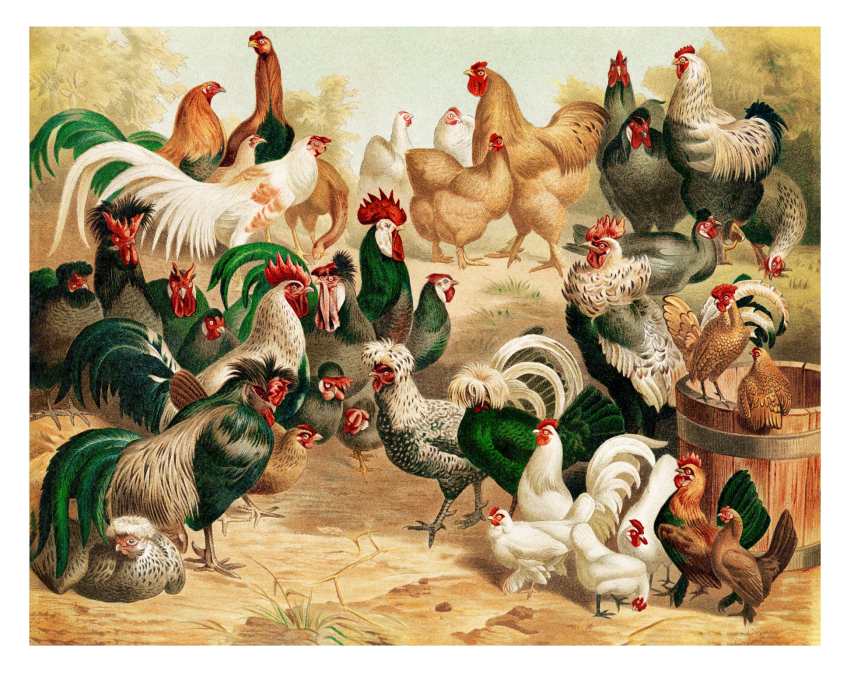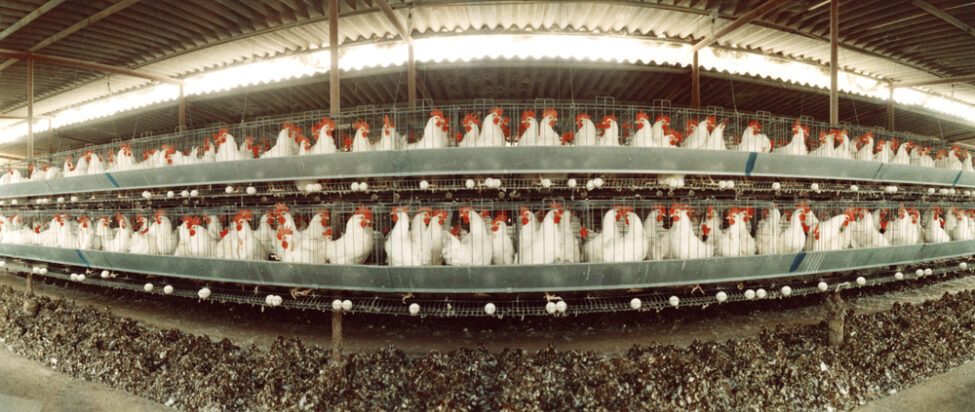
Jonica Newby
1 November 2021
The Australian scientists who are responding to the cry: “Kelp needs help”
13 April 2023

Published by: Cosmos Weekly
Reading Time: 10 mins
Original source: click here
The true story and history of the chicken
Why did the chicken cross the road? Well, to make friends with humans of course! Apologies; the cliché was irresistible. But then so, apparently, were chickens — to our ancestors.
Two extraordinary new archaeological studies ( here and here ) have not only overturned much of what we thought we knew about the domestication of our feathered friends, they’ve revealed that far from being eaten, the earliest chickens were revered; perhaps even loved. Some Iron Age Britons even went so far as to be buried with them!
The studies, between them, mark “archaeology on a scale no one has ever looked at before”, according to co-author; Dr Greger Larson, Professor of Archaeology at Oxford University, who I call to get the story. But before I can ask much, he launches into an enthusiastic illustration of how much we once valued chickens.
Far from being eaten, the earliest chickens were revered; perhaps even loved.
“There’s an Iron Age cemetery in Austria where there’s a bunch of human burials,” he says. “You find metalwork, pottery; things that are meaningful to you. And at the foot of each of these burials there is a chicken: a full adult chicken. And there was some isotopic work done and it suggested that these weren’t just random chickens, these were these people’s chickens. The chickens were eating the same food as the people! So, it’s not like they were putting a chicken in to eat in the afterlife, it was — this was your chicken and chickens are important so you get to go with your chicken.”
“It’s really only post World War Two that we started regarding chickens with disrespect; making them the butt of jokes like “chicken-shit” he adds (possibly because I rashly suggested chickens were a “humble” archaeological topic). “We denigrate them to make it easier to eat them. Before that, they were venerated. Look at any church steeple and you are going to find a chicken on top. You not going to put something you hate or think is stupid on the top of a church.”

The first of the two studies painstakingly re-examined archaeological evidence, from 600 sites in 89 countries, to establish exactly how it was chickens came to join us, before spreading so widely they are now the world’s most ubiquitous domestic animal, with 10 chickens for every human. The second concentrated on the arrival of the chicken in Europe; radiocarbon dating 23 ancient chickens to determine how, when and why they spread.
“It’s really only post World War Two that we started regarding chickens with disrespect; making them the butt of jokes like “chicken-shit”.”
Greger Larson
So here, then, is the true story of the chicken.
It begins around 3,500 years ago – not 8,000 years ago as previously thought – in central Thailand, home to the first unambiguous domestic chicken remains. This date corresponds beautifully with the introduction of a new form of agriculture in the region; dry rice farming and millet cultivation. Also living in central Thailand was the chicken’s ancestor; the red junglefowl (genetic studies have recently narrowed it down to the subspecies Gallus gallus spadiceus.) Suddenly, with grain stored or just lying on the ground, there’s an attractive new food for the fowl.
“That serves as the magnet – the tractor beam that draws the chickens in,” explains Professor Larson. “So the birds are perhaps initially tolerated rather than actively encouraged.”
Like many domestic animals, including dogs, the relationship starts in a commensal fashion, with the birds scavenging off human settlements. Presumably, it follows a typical domestication pattern: the tamest animals with the best temperaments tend to thrive, while the ones that attack people are more likely to be removed as a nuisance – and this starts a genetic drift from ancestral populations.
But things swiftly shift because as the new agriculture spreads west, so do chickens.

Digitally restored antique illustration of various chicken breeds. Credit: mikroman6/Getty Images
They are in East Asia by 3,000 years ago, in central Asia by 2500 years ago, and beginning to separate from their ancestors altogether. Interestingly, as they continue to spread west, chickens leave behind rice cultivation and are taking advantage of other grains; wheat, barley. They also become incorporated into human culture, cementing their close relationship with us. By 800 BC (2800 years ago), chickens have made it as far as Italy.
Professor Larson likes to imagine the excited reaction when Europeans first saw this exotic bird. “It’s like ‘oh my gosh; look at this bird’. Everything in Europe is brown. These chickens come in and they’re bright colours, the male plumage is ridiculous, they crow in the morning and they have these personalities, they make these soft clucking sound. People are like, ‘This is amazing.’”
The detailed European analysis; the subject of the second study; gives us an even more intriguing insight into our relationship with chickens; which always begins with a lengthy honeymoon period, before taking a darker turn.
“These chickens come in and they’re bright colours, the male plumage is ridiculous, they crow in the morning and they have these personalities, they make these soft clucking sound. People are like, ‘This is amazing.’”
Greger Larson
By 500 – 600 BC, chickens are found in central Europe, France and Britain. Tellingly, none of those earliest remains show any signs of butchery or human consumption, indicating chickens were too rare or important to eat. A mature hen from a Weston Downs site in the UK even shows a well healed fracture, suggesting tender human care.
During the Roman era in Britain (AD 208–11), there is a noticeable increase in chicken numbers, and in human–chicken co-burials. The funerary rites are often strongly gendered; men are buried with cockerels and women with hens. The study authors suggest the chickens may have been put there to lead human souls to the afterlife; which would fit their association with Mercury, the Roman God of communication and travel. Later burials though may indicate a food source.
Chickens also become strongly associated with Christianity; hence the church steeples.
And of course, as well as being exotic, having gorgeous feathers, making lovely clucking sounds (soothing as a purr), announcing dawn in the morning and producing extremely cute chicks – a magnet to children – chickens lay eggs. Which become very popular in Roman times.
“There are excavations of Roman amphitheatres where you find stacks and stacks of chicken egg shells,” says Professor Larson. “So you can imagine like any major sporting event today you’ll have people walking up the aisle selling food, selling peanuts. And this guy just had a bunch of eggs. The Vikings were also a really big fan because eggs keep for so long.”
But as soon as humans become infatuated by chickens, a slightly sinister clock starts ticking on the love affair.
Modern Easter – a mixture of pagan and Christian rituals – still glorifies eggs.
But as soon as humans become infatuated by chickens, a slightly sinister clock starts ticking on the love affair.
Chickens originated as a warm climate bird – and migrate readily east west along similar latitudes. The European analysis reveals it takes another thousand years for chickens to disperse north to colder climes; they don’t show up in Scotland, Scandinavia or Iceland until around 500 – 800 AD. Because of this step-wise spread, from Roman Italy to Britain, and north and west, the scientist were able to determine exactly how long after humans acquire chickens, we begin cutting and eating them.
“It takes around 500 years,” says Professor Larson. “Chickens show up, you press play and initially everyone is like wow, these chickens are amazing. Fast forward 500 years and it’s like boring chickens, and we start eating them. Familiarity breeds a perfectly acceptable food source. Each new place starts as pure reverence and then the clock starts ticking. ”
These days, the clock has ticked into a rather dystopian relationship with chickens. Most humans eat them and prefer not to think about them. But we can still see our ancestral love and friendship in the backyard chook or at a local country show. Check out the poultry pavilion with its fantabulous array of fancy chickens – and feel the reverence take flight once more.



